2021-2022学年人教版七年级英语上册Unit 6 Do you like bananas? 5课时教案
文档属性
| 名称 | 2021-2022学年人教版七年级英语上册Unit 6 Do you like bananas? 5课时教案 | 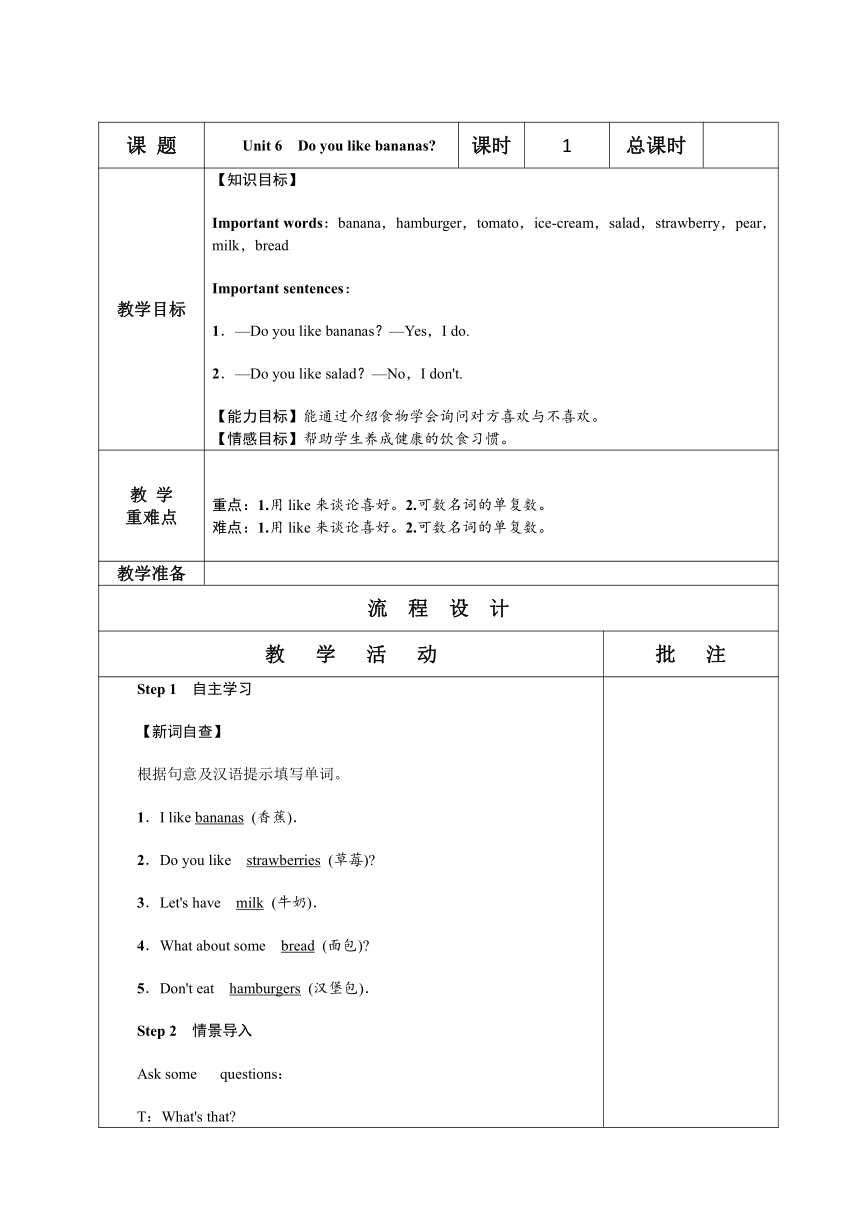 | |
| 格式 | zip | ||
| 文件大小 | 92.6KB | ||
| 资源类型 | 教案 | ||
| 版本资源 | 人教新目标(Go for it)版 | ||
| 科目 | 英语 | ||
| 更新时间 | 2021-07-06 08:21:38 | ||
图片预览

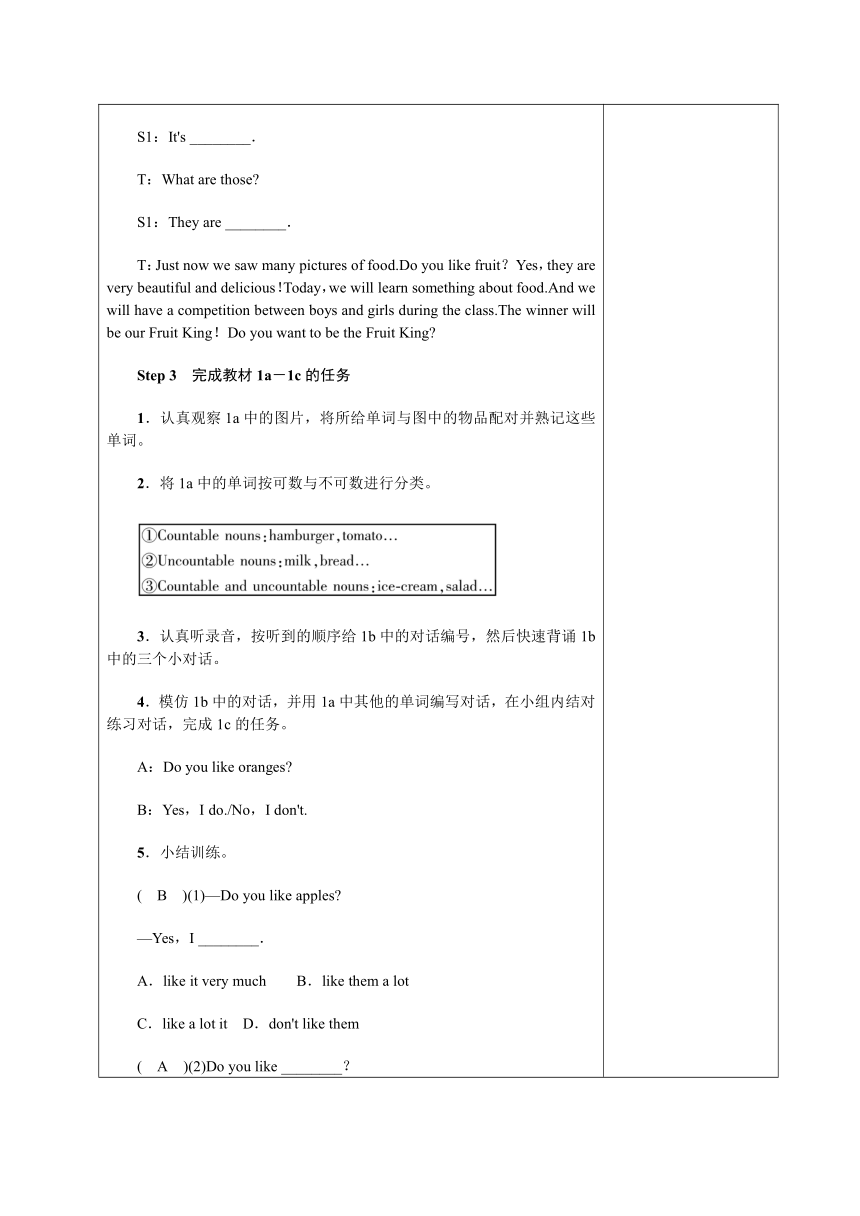
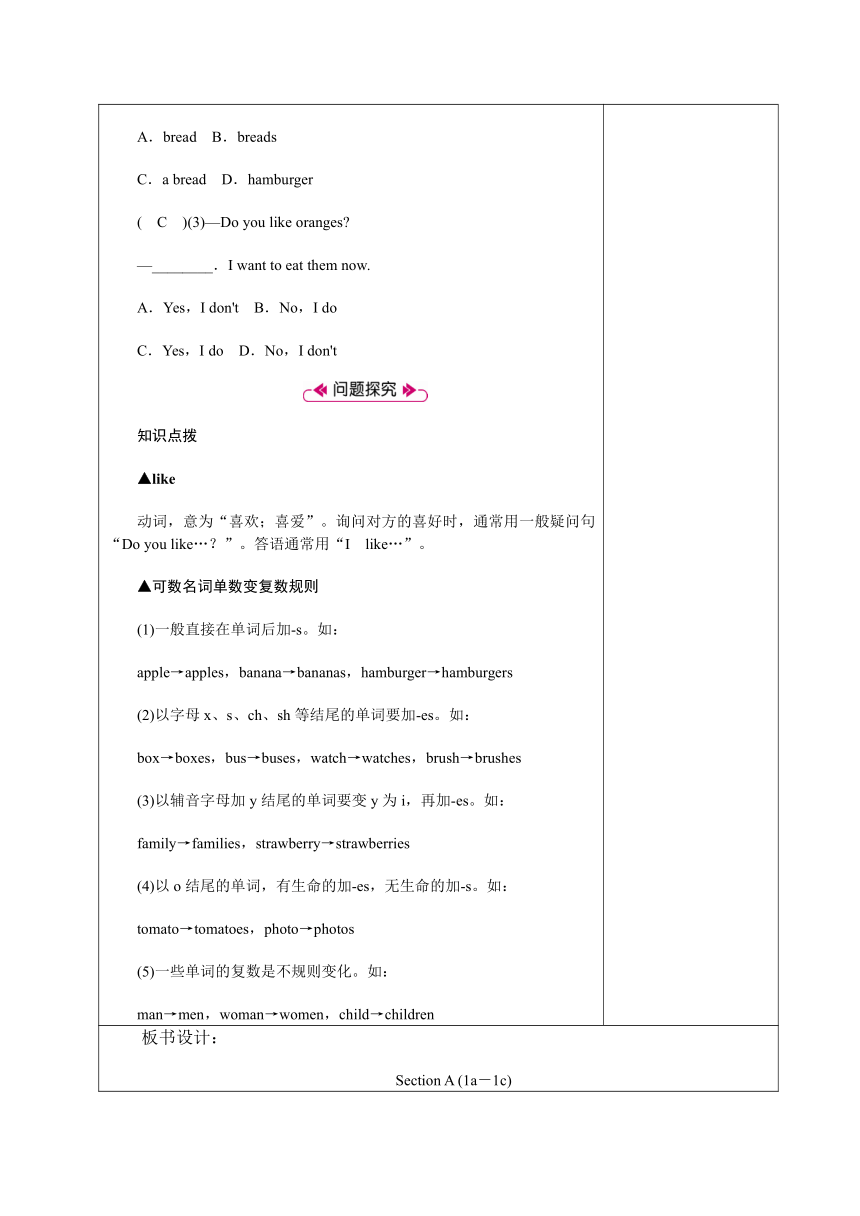
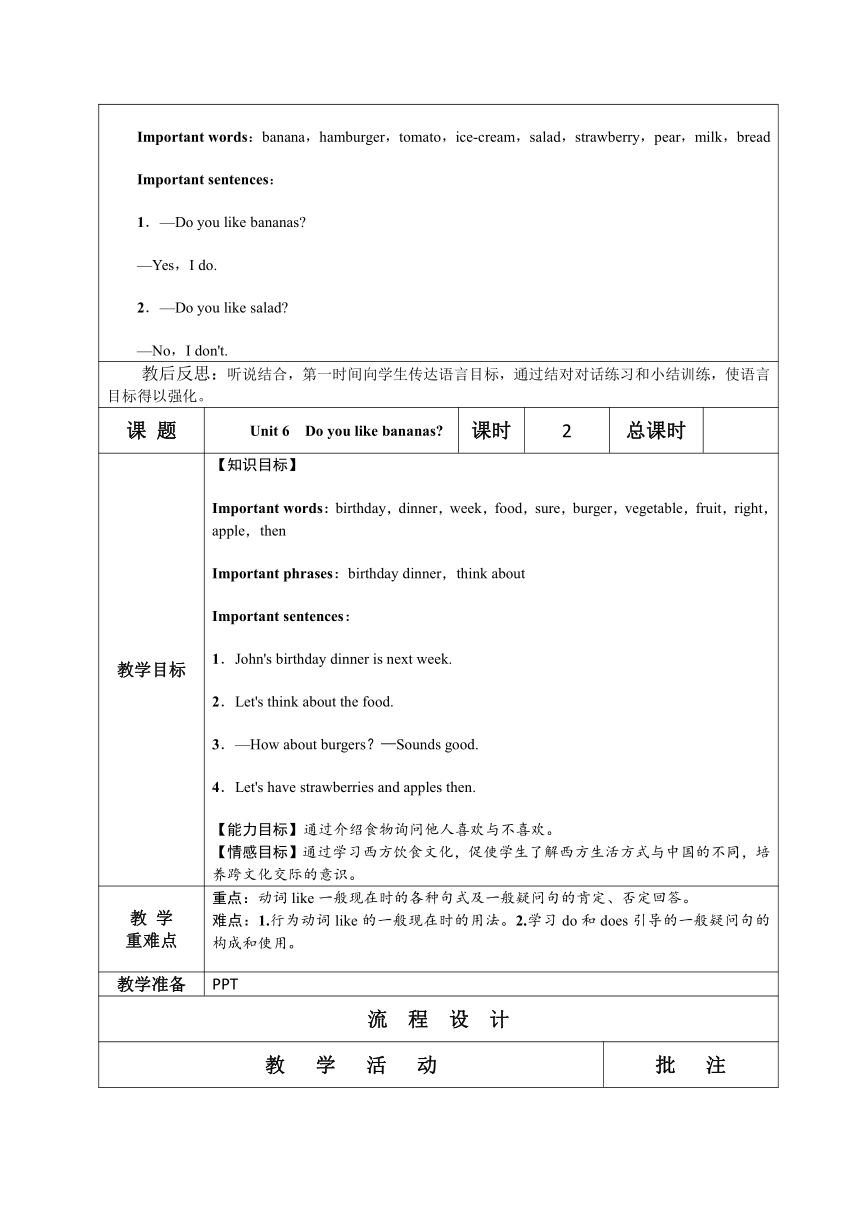
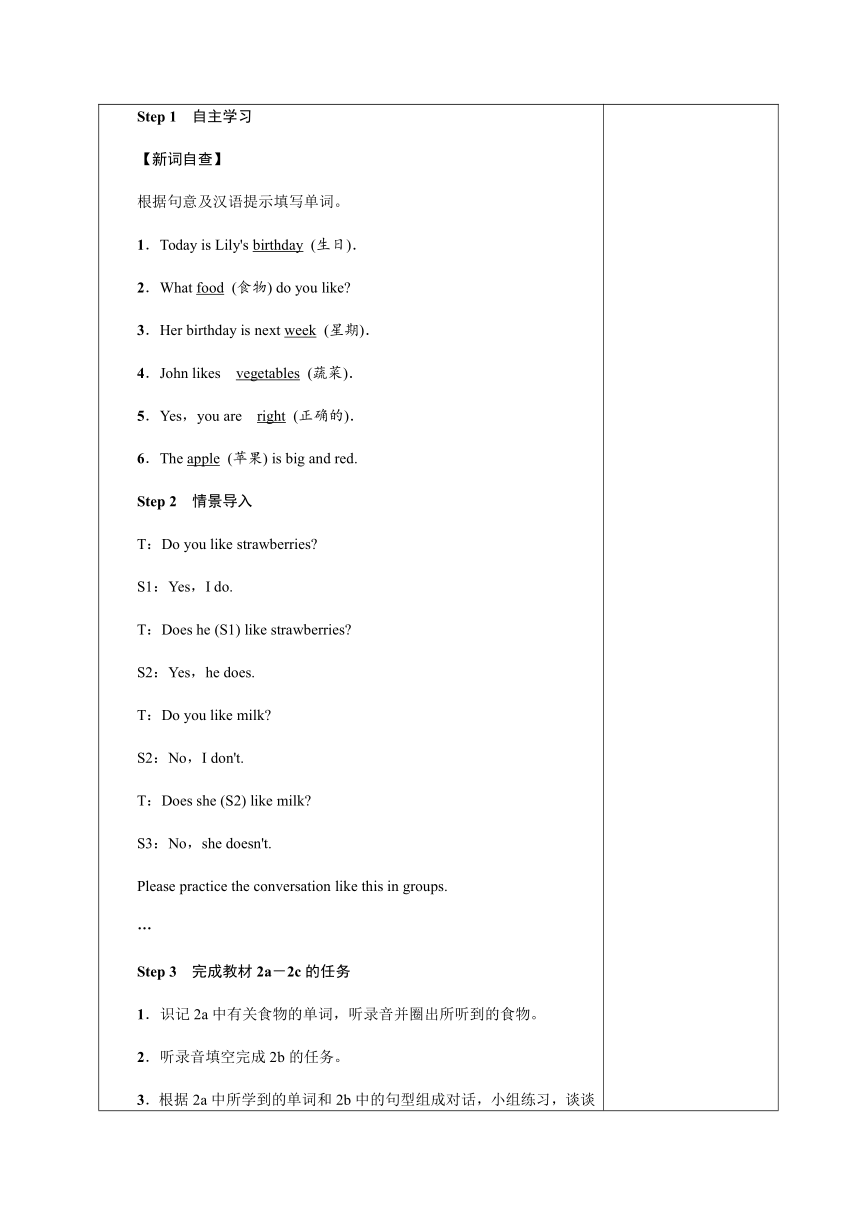
文档简介
课
题
Unit
6 Do
you
like
bananas?
课时
1
总课时
教学目标
【知识目标】
Important
words:banana,hamburger,tomato,ice?cream,salad,strawberry,pear,milk,bread
Important
sentences:
1.—Do
you
like
bananas?—Yes,I
do.
2.—Do
you
like
salad?—No,I
don't.
【能力目标】能通过介绍食物学会询问对方喜欢与不喜欢。
【情感目标】帮助学生养成健康的饮食习惯。
教
学
重难点
重点:1.用like来谈论喜好。2.可数名词的单复数。
难点:1.用like来谈论喜好。2.可数名词的单复数。
教学准备
流
程
设
计
教
学
活
动
批
注
Step
1 自主学习
【新词自查】
根据句意及汉语提示填写单词。
1.I
like
bananas
(香蕉).
2.Do
you
like
strawberries
(草莓)?
3.Let's
have
milk
(牛奶).
4.What
about
some
bread
(面包)?
5.Don't
eat
hamburgers
(汉堡包).
Step
2 情景导入
Ask
some
questions:
T:What's
that?
S1:It's
________.
T:What
are
those?
S1:They
are
________.
T:Just
now
we
saw
many
pictures
of
food.Do
you
like
fruit?Yes,they
are
very
beautiful
and
delicious!Today,we
will
learn
something
about
food.And
we
will
have
a
competition
between
boys
and
girls
during
the
class.The
winner
will
be
our
Fruit
King!Do
you
want
to
be
the
Fruit
King?
Step
3 完成教材1a-1c的任务
1.认真观察1a中的图片,将所给单词与图中的物品配对并熟记这些单词。
2.将1a中的单词按可数与不可数进行分类。
3.认真听录音,按听到的顺序给1b中的对话编号,然后快速背诵1b中的三个小对话。
4.模仿1b中的对话,并用1a中其他的单词编写对话,在小组内结对练习对话,完成1c的任务。
A:Do
you
like
oranges?
B:Yes,I
do./No,I
don't.
5.小结训练。
( B )(1)—Do
you
like
apples?
—Yes,I
________.
A.like
it
very
much B.like
them
a
lot
C.like
a
lot
it
D.don't
like
them
( A )(2)Do
you
like
________?
A.bread
B.breads
C.a
bread
D.hamburger
( C )(3)—Do
you
like
oranges?
—________.I
want
to
eat
them
now.
A.Yes,I
don't
B.No,I
do
C.Yes,I
do
D.No,I
don't
知识点拨
▲like
动词,意为“喜欢;喜爱”。询问对方的喜好时,通常用一般疑问句“Do
you
like…?”。答语通常用“I
like…”。
▲可数名词单数变复数规则
(1)一般直接在单词后加?s。如:
apple→apples,banana→bananas,hamburger→hamburgers
(2)以字母x、s、ch、sh等结尾的单词要加?es。如:
box→boxes,bus→buses,watch→watches,brush→brushes
(3)以辅音字母加y结尾的单词要变y为i,再加?es。如:
family→families,strawberry→strawberries
(4)以o结尾的单词,有生命的加?es,无生命的加?s。如:
tomato→tomatoes,photo→photos
(5)一些单词的复数是不规则变化。如:
man→men,woman→women,child→children
板书设计:
Section
A
(1a-1c)
Important
words:banana,hamburger,tomato,ice?cream,salad,strawberry,pear,milk,bread
Important
sentences:
1.—Do
you
like
bananas?
—Yes,I
do.
2.—Do
you
like
salad?
—No,I
don't.
教后反思:听说结合,第一时间向学生传达语言目标,通过结对对话练习和小结训练,使语言目标得以强化。
课
题
Unit
6 Do
you
like
bananas?
课时
2
总课时
教学目标
【知识目标】
Important
words:birthday,dinner,week,food,sure,burger,vegetable,fruit,right,apple,then
Important
phrases:birthday
dinner,think
about
Important
sentences:
1.John's
birthday
dinner
is
next
week.
2.Let's
think
about
the
food.
3.—How
about
burgers?—Sounds
good.
4.Let's
have
strawberries
and
apples
then.
【能力目标】通过介绍食物询问他人喜欢与不喜欢。
【情感目标】通过学习西方饮食文化,促使学生了解西方生活方式与中国的不同,培养跨文化交际的意识。
教
学
重难点
重点:动词like一般现在时的各种句式及一般疑问句的肯定、否定回答。
难点:1.行为动词like的一般现在时的用法。2.学习do和does引导的一般疑问句的构成和使用。
教学准备
PPT
流
程
设
计
教
学
活
动
批
注
Step
1 自主学习
【新词自查】
根据句意及汉语提示填写单词。
1.Today
is
Lily's
birthday
(生日).
2.What
food
(食物)
do
you
like?
3.Her
birthday
is
next
week
(星期).
4.John
likes
vegetables
(蔬菜).
5.Yes,you
are
right
(正确的).
6.The
apple
(苹果)
is
big
and
red.
Step
2 情景导入
T:Do
you
like
strawberries?
S1:Yes,I
do.
T:Does
he
(S1)
like
strawberries?
S2:Yes,he
does.
T:Do
you
like
milk?
S2:No,I
don't.
T:Does
she
(S2)
like
milk?
S3:No,she
doesn't.
Please
practice
the
conversation
like
this
in
groups.
…
Step
3 完成教材2a-2c的任务
1.识记2a中有关食物的单词,听录音并圈出所听到的食物。
2.听录音填空完成2b的任务。
3.根据2a中所学到的单词和2b中的句型组成对话,小组练习,谈谈自己的实际情况,完成2c的任务。
Step
4 完成教材2d的任务
1.学生自读对话,回答下面的问题:
(1)When
is
John's
birthday?
(2)Does
John
like
hamburgers?
(3)What
fruit
does
John
like?
2.大声朗读2d对话,然后与同伴结对练习,分角色表演对话。
3.邀请三组学生来上台表演。
4.小结训练。
翻译句子。
(1)让我们考虑一下食物吧。
Let's__think__about__the__food.
(2)我的生日宴会在下周。
My
birthday
dinner
is
next
week.
(3)让我们吃一些西红柿吧。
Let's__have____some__tomatoes.
(4)苹果怎么样呢?
What__about__apples?
知识点拨
▲think
about
think
about为固定短语,意为“考虑”。about是介词,后面常接名词、代词或v?ing。如:
Let's
think
about
the
food.让我们考虑下食物吧。
This
book
is
interesting.Let's
think
about
it.这本书很有趣,让我们考虑一下它吧。
Let's
think
about
watching
TV.我们考虑一下看电视吧。
▲how
about
“How
about
…?”意为“……怎么样呢?”是提建议经常用到的句型之一,可以与“What
about
…?”互换使用,about是介词,后面常接名词、代词或v?ing。如:
How
about
this
book?这本书怎么样呢?
How
about
having
bananas?吃香蕉怎么样呢?
板书设计:
Section
A
(2a-2d)
Important
words:birthday,dinner,week,food,sure,burger,vegetable,fruit,right,apple,then
Important
phrases:birthday
dinner,think
about
Important
sentences1.John's
birthday
dinner
is
next
week.2.Let's
think
about
the
food.
3.—How
about
burgers?—Sounds
good.4.Let's
have
strawberries
and
apples
then.
教后反思:在本课时中目标设计清晰可操作,活动的设计紧扣目标要求并与目标达成一致。
课
题
Unit
6 Do
you
like
bananas?
课时
3
总课时
教学目标
【知识目标】
Important
words:egg,carrot,rice,chicken,so
Important
phrase:ask
sb.
about
sth.
Important
sentences:
1.I
like
fruit,but
I
don't
like
vegetables.
2.He
likes
bananas,but
he
doesn't
like
oranges.
【能力目标】1.继续学习描述自己或他人喜欢或不喜欢的食物,能够用but来表达简单的句子。2.总结动词like一般现在时的肯定句式、否定句式及一般疑问句的肯定、否定回答。3.复习可数名词复数的知识。4.理解英语中可数名词与不可数名词的概念,并对所学过的部分词汇按此分类进行归纳总结。
【情感目标】1.通过任务型活动,使学生学会在实际生活中均衡饮食,合理配餐。2.通过开展小组活动,指导学生积极与他人合作,培养他们的合作精神。
教
学
重难点
重点:1.总结动词like一般现在时的肯定句式、否定句式及一般疑问句的肯定、否定回答。2.理解英语中可数名词与不可数名词的概念,并对所学过的部分词汇按此分类进行归纳总结。
难点:理解英语中可数名词与不可数名词的概念,并对所学过的部分词汇按此分类进行归纳总结。
教学准备
PPT
流
程
设
计
教
学
活
动
批
注
Step
1 自主学习
【语法自测】
一、根据句意,用括号内所给单词的适当形式填空。
1.I
like
(like)
hamburgers.
2.Does
he
like
(like)
eggs?
3.Lily
doesn't
like
(not
like)
chicken.
4.Tom
and
Jim
don't
like
(not
like)
chicken.
5.My
little
brother
likes
(like)
ice?cream
very
much.
二、按要求完成句子,每空一词。
1.I
like
vegetables.(改为一般疑问句并作肯定回答)
—
Do
you
like
vegetables?
—Yes,I
do
.
2.He
likes
hamburgers.(改为否定句)
He
doesn't
like
hamburgers.
3.Jane
likes
bananas.(改为一般疑问句并作否定回答)
—
Does
Jane
like
bananas?
—No,she
doesn't
.
4.They
like
strawberries.(用she替换they改写句子)
She
likes
strawberries.
Step
2 情景导入
T:Do
you
like
tomatoes/oranges/salad…?
S1:Yes,I
do./No,I
don't,but
I
like…
T:Does
she/he
like
tomatoes/oranges/salad…?
S2:Yes,she/he
does./No,she/he
doesn't,but
she/he
likes…
Step
3 畅通Grammar
Focus回顾语法重点
1.学生阅读Grammar
Focus中的句子,总结含有实义动词的一般现在时的句型规律。
2.阅读方框中可数名词和不可数名词,并对所学过的部分词汇按此分类进行归纳总结。
Step
4 完成教材3a-3c的任务
1.认真阅读3a的5个句子,并在括号内正确的单词下面画线,使句子正确完整。
2.学生说出答案,老师核对,然后让学生大声朗读这些句子,并背诵。
3.认真阅读3b的几个句子,将其编号,组成对话,然后读背。
4.做食物调查。用“Do
you
like…?”句型就3c表格中的食物向小组成员提问。找出他们喜欢和不喜欢的食物,并把结果登记在表格中。
知识点拨
▲可数名词与不可数名词的含义与特点
含义特点不可数
名词指不可以直接计数的名词,它只有单数形式。不可以与a,an或数词连用,要表示数量的多少时,其前可以加some,any或表数量的短语。如:
some
bread
一些面包
a
cup
of
milk
一杯牛奶可数
名词指可以用来计数的名词,它有单数和复数两种形式。可以用a,an或具体的数词修饰。如:
a
tomato
一个西红柿
an
egg
一个鸡蛋
two
pears
两个梨既是可
数名词
又是不
可数名词有些词,既可用作可数名词,也可以用作不可数名词,但意义却不同。如:
可数名词 不可数名词
chicken
小鸡
鸡肉
food
各种食物
食物
glass
玻璃杯;眼镜
玻璃
板书设计:
Section
A
(Grammar
Focus-3c)
Important
words:egg,carrot,rice,chicken,so
Important
phrase:ask
sb.
about
sth.
Important
sentences:
1.I
like
fruit,but
I
don't
like
vegetables.
2.He
likes
bananas,but
he
doesn't
like
oranges.
教后反思:
本节课我从不同的角度带领学生畅通Grammar
Focus:朗读、讨论、问答、对话展示、小组归纳等,将听、说、读、写的任务结合起来,不仅锻炼了学生的语言综合运用能力,而且巩固了学生对目标语言的学习、识记和运用。
课
题
Unit
6 Do
you
like
bananas?
课时
4
总课时
教学目标
【知识目标】
Important
words:breakfast,lunch
Important
sentence:—Does
Tom
like
carrots?—Yes,he
does.
【能力目标】1.继续学习有关膳食名词:breakfast,lunch,dinner,egg,apple,chicken,fruit,vegetable,并能按食品、水果和蔬菜进行分类总结。2.理解可数名词与不可数名词的概念,并能对所学的词汇进行分辨。3.就食物的话题开展听、说、读、写技能的训练,促进学生语言运用能力的提高。
【情感目标】该部分学习内容涉及学生的饮食习惯和偏爱,对培养学生健康的饮食习惯有很强的指导性,能引起学生的特别关注;同时通过互相询问和谈论,培养对家人、同学和朋友的关怀和友爱之情。
教
学
重难点
重点:1.继续学习运用有关食物的词汇并能按食品、水果和蔬菜进行分类总结。2.就食物的话题开展听、说、读、写技能的训练,促进学生语言运用能力的提高。
难点:就食物的话题开展听、说、读、写技能的训练,促进学生语言运用能力的提高。
教学准备
PPT
流
程
设
计
教
学
活
动
批
注
Step
1 自主学习
【新词自查】
根据句意及汉语提示填写单词。
1.I
have
bread
and
eggs
for
breakfast
(早餐).
2.What
do
you
have
for
lunch
(午餐)?
3.Mike
likes
chicken
(鸡肉)very
much.
4.I
don't
like
bananas
(香蕉).
5.—Does
Sandy
like
rice
(米饭)?
—Yes,she
does.
Step
2 情景导入
1.Review
the
words
about
food.And
list
them
into
countable
nouns,uncountable
nouns,countable
and
uncountable
nouns.
2.Students
read
and
try
to
remember
the
new
words.
3.Review
the
plural
forms
of
countable
nouns.
Step
3 完成教材1a-1e的任务
Presentation
1.T:How
many
meals
do
you
have
every
day?
Ss:Three.
T:What
are
they?
(The
students
can
answer
them
in
Chinese.)
Ss:They
are
早餐、中餐和晚餐.
T:Oh,yes.In
English
“早餐”we
can
say
“breakfast”.
(Show
a
picture
of
the
breakfast.)Read
after
me,breakfast.B?R?E?A?K?F?A?S?T,breakfast.
Ss:B?R?E?A?K?F?A?S?T,breakfast.
T:Do
you
have
your
breakfast
every
day?
S1:No,sometimes
I
get
up
late.I
have
no
time
to
eat
it.
T:I
think
it's
not
good
for
your
health.
(Teach
the
other
two
words
“lunch”“dinner”
in
the
same
way.)
Pre?listening
1.Look
at
1a,read
the
words
in
the
box,and
then
write
the
number
in
the
box
next
to
the
correct
food.The
students
finish
1a.
2.Look
at
1b.How
many
other
words
can
you
add
to
the
lists?Try
to
write
them
down
in
the
lists.
While?listening
T:Look!There
are
so
many
foods.Maybe
they
are
very
delicious.Which
food
do
you
like?Do
you
like
tomatoes?(Show
the
picture.)
S1:…
T:Yes,you
are
right.I
think
you
are
very
lucky.But
I
have
two
friends.They
are
Sally
and
Tom.Do
you
know
what
food
they
like?Now,let's
listen
and
circle
the
food
you
hear
in
1a.
(Play
the
recording
1c
in
Section
B.The
students
find
out
each
food
mentioned
in
the
conversation
on
the
recording.Then
check
the
answers.)
T:Now
listen
again.Fill
in
the
chart
in
1d.
Post?listening
1.Ask
and
answer
questions
about
what
Sally
and
Tom
like
and
don't
like.The
students
finish
1e.
2.Work
in
groups
and
make
a
menu
of
three
meals
for
a
Western
friend.
知识点拨
▲辨析how
many与how
much
两者都意为“多少”,how
many后接可数名词的复数形式,how
much后接不可数名词。
板书设计:
Section
B
(1a-1e)
Important
words:breakfast,lunch
Important
sentence:
—Does
Tom
like
carrots?
—Yes,he
does.
教后反思:
本节课通过听、说训练获取了有效信息,通过听力检查了学生是否能听懂目标词汇与基本句型,是否能用目标词汇回答问题。学生大多能够熟练地运用本课句型回答问题,能够在实际生活中运用目标语言,从而理解并掌握本课知识。
课
题
Unit
6 Do
you
like
bananas?
课时
5
总课时
教学目标
【知识目标】
Important
words:star,eat,well,habit,healthy,really,question,want,fat
Important
phrases:sports
star,ask
sb.
about
sth.,eating
habits,for
breakfast,after
dinner,want
to
do
sth.,healthy
food,at
least
Important
sentences:
1.Sports
star
eats
well!
2.David
asks
the
volleyball
star,Cindy
Smith,about
her
eating
habits.
3.What
do
you
like
for
breakfast?
4.I
don't
want
to
be
fat.5.—Do
you
like
eggs
for
breakfast?—No,I
don't.I
like
oranges.
【能力目标】1.继续学习描述自己或他人喜欢或不喜欢的食物,能够用but来表达简单的句子。2.阅读有关食物喜好的短文,并能获得相关信息,进一步巩固和运用所学语言。3.由询问所喜欢的食物再拓展到所喜欢的运动和颜色来进一步复习所学习的句型结构。4.通过写作练习来提高学生的综合表达能力。
【情感目标】通过谈论自己与他人早、中、晚餐喜欢吃的食物,养成良好的饮食习惯。2.通过互相询问和谈论饮食习惯、培养对家人、同学和朋友的关怀和友爱之情并学会营养配餐。
教
学
重难点
重点:1.重点短语和句型。2.一日三餐饮食的叙述。
难点:1.重点短语和句型。2.一日三餐饮食的叙述。
教学准备
PPT
流
程
设
计
教
学
活
动
批
注
Step
1 自主学习
【新词自查】
根据句意及汉语提示填写单词。
1.Li
Na
is
a
sports
star
(明星).
2.Tom
plays
basketball
very
well
(好).
3.The
sports
player,Liu
Xiang,
eats
(吃)
well.
4.Can
you
tell
me
about
your
eating
habits
(习惯)?
5.Mary
really
(真正地)
likes
bananas
very
much.
Step
2 情景导入
T:We
all
know
that
a
healthy
eating
habit
helps
us
keep
healthy
and
get
good
grades.So
what
is
healthy
food
and
what
is
unhealthy
food?What
do
you
eat
for
breakfast,lunch
and
dinner?Do
you
want
to
know
what
the
sports
star
Cindy
Smith
eats
for
three
meals?Let's
read
the
magazine
article
to
find
the
answer.
Step
3 完成教材2a-2c的任务
1.认真考虑2a中的食物,你认为哪种食物健康?在Yes、Maybe或No下打钩。
2.快速阅读2b短文,了解短文大意,然后圈出食物名称。
3.认真阅读短文,回答下面的问题。
(1)What
does
Cindy
like
for
dinner?
Chicken.
(2)What
fruit
does
Cindy
like?
Oranges
and
apples.
(3)Does
Cindy
eat
ice?cream
after
dinner?
No,she__doesn't.
4.再一次认真阅读短文,写5个句子谈谈Cindy的饮食习惯。完成后小组内交流答案,完成2c。
Step
4 完成教材3a-3b的任务
1.请同学们根据3a表格内容提示,填好自己一日三餐喜欢和不喜欢的食物,再用“Do
you
like…for
breakfast/lunch/dinner?”句型来询问你的搭档一日三餐喜欢和不喜欢的食物,根据搭档的回答来完成3a的表格。
2.根据3a表格中所填的内容,写出你和搭档一日三餐喜欢和不喜欢的食物,完成3b。
Step
5 完成教材Self
Check
1.认真观察Self
Check
1表格中的单词,按照名词单数变复数的规则把它们写在相应的栏目里,小组核对答案,教师点拨。
2.你父母喜欢什么食物、运动和颜色?不喜欢什么?写出至少五个句子来向你的同学做介绍。
知识点拨
▲I
like
chicken
for
dinner.我晚餐喜欢吃鸡肉。
“like+食品名词+for+某餐”表示“某餐喜欢吃什么”。
▲I
don't
want
to
be
fat.我不想变胖。
want意为“需要;想要”。want
to
do
sth.意为“想要做某事”。
板书设计:
Section
B
(2a-3b)&
Self
Check
Important
words:star,eat,well,habit,healthy,really,question,want,fat
Important
phrases:sports
star,ask
sb.
about
sth.,eating
habits,for
breakfast,after
dinner,want
to
do
sth.,healthy
food,at
least
Important
sentences:
1.Sports
star
eats
well!
2.David
asks
the
volleyball
star,Cindy
Smith,about
her
eating
habits.
3.What
do
you
like
for
breakfast?
4.I
don't
want
to
be
fat.
5.—Do
you
like
eggs
for
breakfast?
—No,I
don't.I
like
oranges.
教后反思:
通过本节课学习,大部分学生已经学会抓取关键词来获取有效信息,并且也学会了自主阅读文章并寻找答案。学生能在老师的引导下,做一些开放性的训练,学生的综合实践能力得到提高。
题
Unit
6 Do
you
like
bananas?
课时
1
总课时
教学目标
【知识目标】
Important
words:banana,hamburger,tomato,ice?cream,salad,strawberry,pear,milk,bread
Important
sentences:
1.—Do
you
like
bananas?—Yes,I
do.
2.—Do
you
like
salad?—No,I
don't.
【能力目标】能通过介绍食物学会询问对方喜欢与不喜欢。
【情感目标】帮助学生养成健康的饮食习惯。
教
学
重难点
重点:1.用like来谈论喜好。2.可数名词的单复数。
难点:1.用like来谈论喜好。2.可数名词的单复数。
教学准备
流
程
设
计
教
学
活
动
批
注
Step
1 自主学习
【新词自查】
根据句意及汉语提示填写单词。
1.I
like
bananas
(香蕉).
2.Do
you
like
strawberries
(草莓)?
3.Let's
have
milk
(牛奶).
4.What
about
some
bread
(面包)?
5.Don't
eat
hamburgers
(汉堡包).
Step
2 情景导入
Ask
some
questions:
T:What's
that?
S1:It's
________.
T:What
are
those?
S1:They
are
________.
T:Just
now
we
saw
many
pictures
of
food.Do
you
like
fruit?Yes,they
are
very
beautiful
and
delicious!Today,we
will
learn
something
about
food.And
we
will
have
a
competition
between
boys
and
girls
during
the
class.The
winner
will
be
our
Fruit
King!Do
you
want
to
be
the
Fruit
King?
Step
3 完成教材1a-1c的任务
1.认真观察1a中的图片,将所给单词与图中的物品配对并熟记这些单词。
2.将1a中的单词按可数与不可数进行分类。
3.认真听录音,按听到的顺序给1b中的对话编号,然后快速背诵1b中的三个小对话。
4.模仿1b中的对话,并用1a中其他的单词编写对话,在小组内结对练习对话,完成1c的任务。
A:Do
you
like
oranges?
B:Yes,I
do./No,I
don't.
5.小结训练。
( B )(1)—Do
you
like
apples?
—Yes,I
________.
A.like
it
very
much B.like
them
a
lot
C.like
a
lot
it
D.don't
like
them
( A )(2)Do
you
like
________?
A.bread
B.breads
C.a
bread
D.hamburger
( C )(3)—Do
you
like
oranges?
—________.I
want
to
eat
them
now.
A.Yes,I
don't
B.No,I
do
C.Yes,I
do
D.No,I
don't
知识点拨
▲like
动词,意为“喜欢;喜爱”。询问对方的喜好时,通常用一般疑问句“Do
you
like…?”。答语通常用“I
like…”。
▲可数名词单数变复数规则
(1)一般直接在单词后加?s。如:
apple→apples,banana→bananas,hamburger→hamburgers
(2)以字母x、s、ch、sh等结尾的单词要加?es。如:
box→boxes,bus→buses,watch→watches,brush→brushes
(3)以辅音字母加y结尾的单词要变y为i,再加?es。如:
family→families,strawberry→strawberries
(4)以o结尾的单词,有生命的加?es,无生命的加?s。如:
tomato→tomatoes,photo→photos
(5)一些单词的复数是不规则变化。如:
man→men,woman→women,child→children
板书设计:
Section
A
(1a-1c)
Important
words:banana,hamburger,tomato,ice?cream,salad,strawberry,pear,milk,bread
Important
sentences:
1.—Do
you
like
bananas?
—Yes,I
do.
2.—Do
you
like
salad?
—No,I
don't.
教后反思:听说结合,第一时间向学生传达语言目标,通过结对对话练习和小结训练,使语言目标得以强化。
课
题
Unit
6 Do
you
like
bananas?
课时
2
总课时
教学目标
【知识目标】
Important
words:birthday,dinner,week,food,sure,burger,vegetable,fruit,right,apple,then
Important
phrases:birthday
dinner,think
about
Important
sentences:
1.John's
birthday
dinner
is
next
week.
2.Let's
think
about
the
food.
3.—How
about
burgers?—Sounds
good.
4.Let's
have
strawberries
and
apples
then.
【能力目标】通过介绍食物询问他人喜欢与不喜欢。
【情感目标】通过学习西方饮食文化,促使学生了解西方生活方式与中国的不同,培养跨文化交际的意识。
教
学
重难点
重点:动词like一般现在时的各种句式及一般疑问句的肯定、否定回答。
难点:1.行为动词like的一般现在时的用法。2.学习do和does引导的一般疑问句的构成和使用。
教学准备
PPT
流
程
设
计
教
学
活
动
批
注
Step
1 自主学习
【新词自查】
根据句意及汉语提示填写单词。
1.Today
is
Lily's
birthday
(生日).
2.What
food
(食物)
do
you
like?
3.Her
birthday
is
next
week
(星期).
4.John
likes
vegetables
(蔬菜).
5.Yes,you
are
right
(正确的).
6.The
apple
(苹果)
is
big
and
red.
Step
2 情景导入
T:Do
you
like
strawberries?
S1:Yes,I
do.
T:Does
he
(S1)
like
strawberries?
S2:Yes,he
does.
T:Do
you
like
milk?
S2:No,I
don't.
T:Does
she
(S2)
like
milk?
S3:No,she
doesn't.
Please
practice
the
conversation
like
this
in
groups.
…
Step
3 完成教材2a-2c的任务
1.识记2a中有关食物的单词,听录音并圈出所听到的食物。
2.听录音填空完成2b的任务。
3.根据2a中所学到的单词和2b中的句型组成对话,小组练习,谈谈自己的实际情况,完成2c的任务。
Step
4 完成教材2d的任务
1.学生自读对话,回答下面的问题:
(1)When
is
John's
birthday?
(2)Does
John
like
hamburgers?
(3)What
fruit
does
John
like?
2.大声朗读2d对话,然后与同伴结对练习,分角色表演对话。
3.邀请三组学生来上台表演。
4.小结训练。
翻译句子。
(1)让我们考虑一下食物吧。
Let's__think__about__the__food.
(2)我的生日宴会在下周。
My
birthday
dinner
is
next
week.
(3)让我们吃一些西红柿吧。
Let's__have____some__tomatoes.
(4)苹果怎么样呢?
What__about__apples?
知识点拨
▲think
about
think
about为固定短语,意为“考虑”。about是介词,后面常接名词、代词或v?ing。如:
Let's
think
about
the
food.让我们考虑下食物吧。
This
book
is
interesting.Let's
think
about
it.这本书很有趣,让我们考虑一下它吧。
Let's
think
about
watching
TV.我们考虑一下看电视吧。
▲how
about
“How
about
…?”意为“……怎么样呢?”是提建议经常用到的句型之一,可以与“What
about
…?”互换使用,about是介词,后面常接名词、代词或v?ing。如:
How
about
this
book?这本书怎么样呢?
How
about
having
bananas?吃香蕉怎么样呢?
板书设计:
Section
A
(2a-2d)
Important
words:birthday,dinner,week,food,sure,burger,vegetable,fruit,right,apple,then
Important
phrases:birthday
dinner,think
about
Important
sentences1.John's
birthday
dinner
is
next
week.2.Let's
think
about
the
food.
3.—How
about
burgers?—Sounds
good.4.Let's
have
strawberries
and
apples
then.
教后反思:在本课时中目标设计清晰可操作,活动的设计紧扣目标要求并与目标达成一致。
课
题
Unit
6 Do
you
like
bananas?
课时
3
总课时
教学目标
【知识目标】
Important
words:egg,carrot,rice,chicken,so
Important
phrase:ask
sb.
about
sth.
Important
sentences:
1.I
like
fruit,but
I
don't
like
vegetables.
2.He
likes
bananas,but
he
doesn't
like
oranges.
【能力目标】1.继续学习描述自己或他人喜欢或不喜欢的食物,能够用but来表达简单的句子。2.总结动词like一般现在时的肯定句式、否定句式及一般疑问句的肯定、否定回答。3.复习可数名词复数的知识。4.理解英语中可数名词与不可数名词的概念,并对所学过的部分词汇按此分类进行归纳总结。
【情感目标】1.通过任务型活动,使学生学会在实际生活中均衡饮食,合理配餐。2.通过开展小组活动,指导学生积极与他人合作,培养他们的合作精神。
教
学
重难点
重点:1.总结动词like一般现在时的肯定句式、否定句式及一般疑问句的肯定、否定回答。2.理解英语中可数名词与不可数名词的概念,并对所学过的部分词汇按此分类进行归纳总结。
难点:理解英语中可数名词与不可数名词的概念,并对所学过的部分词汇按此分类进行归纳总结。
教学准备
PPT
流
程
设
计
教
学
活
动
批
注
Step
1 自主学习
【语法自测】
一、根据句意,用括号内所给单词的适当形式填空。
1.I
like
(like)
hamburgers.
2.Does
he
like
(like)
eggs?
3.Lily
doesn't
like
(not
like)
chicken.
4.Tom
and
Jim
don't
like
(not
like)
chicken.
5.My
little
brother
likes
(like)
ice?cream
very
much.
二、按要求完成句子,每空一词。
1.I
like
vegetables.(改为一般疑问句并作肯定回答)
—
Do
you
like
vegetables?
—Yes,I
do
.
2.He
likes
hamburgers.(改为否定句)
He
doesn't
like
hamburgers.
3.Jane
likes
bananas.(改为一般疑问句并作否定回答)
—
Does
Jane
like
bananas?
—No,she
doesn't
.
4.They
like
strawberries.(用she替换they改写句子)
She
likes
strawberries.
Step
2 情景导入
T:Do
you
like
tomatoes/oranges/salad…?
S1:Yes,I
do./No,I
don't,but
I
like…
T:Does
she/he
like
tomatoes/oranges/salad…?
S2:Yes,she/he
does./No,she/he
doesn't,but
she/he
likes…
Step
3 畅通Grammar
Focus回顾语法重点
1.学生阅读Grammar
Focus中的句子,总结含有实义动词的一般现在时的句型规律。
2.阅读方框中可数名词和不可数名词,并对所学过的部分词汇按此分类进行归纳总结。
Step
4 完成教材3a-3c的任务
1.认真阅读3a的5个句子,并在括号内正确的单词下面画线,使句子正确完整。
2.学生说出答案,老师核对,然后让学生大声朗读这些句子,并背诵。
3.认真阅读3b的几个句子,将其编号,组成对话,然后读背。
4.做食物调查。用“Do
you
like…?”句型就3c表格中的食物向小组成员提问。找出他们喜欢和不喜欢的食物,并把结果登记在表格中。
知识点拨
▲可数名词与不可数名词的含义与特点
含义特点不可数
名词指不可以直接计数的名词,它只有单数形式。不可以与a,an或数词连用,要表示数量的多少时,其前可以加some,any或表数量的短语。如:
some
bread
一些面包
a
cup
of
milk
一杯牛奶可数
名词指可以用来计数的名词,它有单数和复数两种形式。可以用a,an或具体的数词修饰。如:
a
tomato
一个西红柿
an
egg
一个鸡蛋
two
pears
两个梨既是可
数名词
又是不
可数名词有些词,既可用作可数名词,也可以用作不可数名词,但意义却不同。如:
可数名词 不可数名词
chicken
小鸡
鸡肉
food
各种食物
食物
glass
玻璃杯;眼镜
玻璃
板书设计:
Section
A
(Grammar
Focus-3c)
Important
words:egg,carrot,rice,chicken,so
Important
phrase:ask
sb.
about
sth.
Important
sentences:
1.I
like
fruit,but
I
don't
like
vegetables.
2.He
likes
bananas,but
he
doesn't
like
oranges.
教后反思:
本节课我从不同的角度带领学生畅通Grammar
Focus:朗读、讨论、问答、对话展示、小组归纳等,将听、说、读、写的任务结合起来,不仅锻炼了学生的语言综合运用能力,而且巩固了学生对目标语言的学习、识记和运用。
课
题
Unit
6 Do
you
like
bananas?
课时
4
总课时
教学目标
【知识目标】
Important
words:breakfast,lunch
Important
sentence:—Does
Tom
like
carrots?—Yes,he
does.
【能力目标】1.继续学习有关膳食名词:breakfast,lunch,dinner,egg,apple,chicken,fruit,vegetable,并能按食品、水果和蔬菜进行分类总结。2.理解可数名词与不可数名词的概念,并能对所学的词汇进行分辨。3.就食物的话题开展听、说、读、写技能的训练,促进学生语言运用能力的提高。
【情感目标】该部分学习内容涉及学生的饮食习惯和偏爱,对培养学生健康的饮食习惯有很强的指导性,能引起学生的特别关注;同时通过互相询问和谈论,培养对家人、同学和朋友的关怀和友爱之情。
教
学
重难点
重点:1.继续学习运用有关食物的词汇并能按食品、水果和蔬菜进行分类总结。2.就食物的话题开展听、说、读、写技能的训练,促进学生语言运用能力的提高。
难点:就食物的话题开展听、说、读、写技能的训练,促进学生语言运用能力的提高。
教学准备
PPT
流
程
设
计
教
学
活
动
批
注
Step
1 自主学习
【新词自查】
根据句意及汉语提示填写单词。
1.I
have
bread
and
eggs
for
breakfast
(早餐).
2.What
do
you
have
for
lunch
(午餐)?
3.Mike
likes
chicken
(鸡肉)very
much.
4.I
don't
like
bananas
(香蕉).
5.—Does
Sandy
like
rice
(米饭)?
—Yes,she
does.
Step
2 情景导入
1.Review
the
words
about
food.And
list
them
into
countable
nouns,uncountable
nouns,countable
and
uncountable
nouns.
2.Students
read
and
try
to
remember
the
new
words.
3.Review
the
plural
forms
of
countable
nouns.
Step
3 完成教材1a-1e的任务
Presentation
1.T:How
many
meals
do
you
have
every
day?
Ss:Three.
T:What
are
they?
(The
students
can
answer
them
in
Chinese.)
Ss:They
are
早餐、中餐和晚餐.
T:Oh,yes.In
English
“早餐”we
can
say
“breakfast”.
(Show
a
picture
of
the
breakfast.)Read
after
me,breakfast.B?R?E?A?K?F?A?S?T,breakfast.
Ss:B?R?E?A?K?F?A?S?T,breakfast.
T:Do
you
have
your
breakfast
every
day?
S1:No,sometimes
I
get
up
late.I
have
no
time
to
eat
it.
T:I
think
it's
not
good
for
your
health.
(Teach
the
other
two
words
“lunch”“dinner”
in
the
same
way.)
Pre?listening
1.Look
at
1a,read
the
words
in
the
box,and
then
write
the
number
in
the
box
next
to
the
correct
food.The
students
finish
1a.
2.Look
at
1b.How
many
other
words
can
you
add
to
the
lists?Try
to
write
them
down
in
the
lists.
While?listening
T:Look!There
are
so
many
foods.Maybe
they
are
very
delicious.Which
food
do
you
like?Do
you
like
tomatoes?(Show
the
picture.)
S1:…
T:Yes,you
are
right.I
think
you
are
very
lucky.But
I
have
two
friends.They
are
Sally
and
Tom.Do
you
know
what
food
they
like?Now,let's
listen
and
circle
the
food
you
hear
in
1a.
(Play
the
recording
1c
in
Section
B.The
students
find
out
each
food
mentioned
in
the
conversation
on
the
recording.Then
check
the
answers.)
T:Now
listen
again.Fill
in
the
chart
in
1d.
Post?listening
1.Ask
and
answer
questions
about
what
Sally
and
Tom
like
and
don't
like.The
students
finish
1e.
2.Work
in
groups
and
make
a
menu
of
three
meals
for
a
Western
friend.
知识点拨
▲辨析how
many与how
much
两者都意为“多少”,how
many后接可数名词的复数形式,how
much后接不可数名词。
板书设计:
Section
B
(1a-1e)
Important
words:breakfast,lunch
Important
sentence:
—Does
Tom
like
carrots?
—Yes,he
does.
教后反思:
本节课通过听、说训练获取了有效信息,通过听力检查了学生是否能听懂目标词汇与基本句型,是否能用目标词汇回答问题。学生大多能够熟练地运用本课句型回答问题,能够在实际生活中运用目标语言,从而理解并掌握本课知识。
课
题
Unit
6 Do
you
like
bananas?
课时
5
总课时
教学目标
【知识目标】
Important
words:star,eat,well,habit,healthy,really,question,want,fat
Important
phrases:sports
star,ask
sb.
about
sth.,eating
habits,for
breakfast,after
dinner,want
to
do
sth.,healthy
food,at
least
Important
sentences:
1.Sports
star
eats
well!
2.David
asks
the
volleyball
star,Cindy
Smith,about
her
eating
habits.
3.What
do
you
like
for
breakfast?
4.I
don't
want
to
be
fat.5.—Do
you
like
eggs
for
breakfast?—No,I
don't.I
like
oranges.
【能力目标】1.继续学习描述自己或他人喜欢或不喜欢的食物,能够用but来表达简单的句子。2.阅读有关食物喜好的短文,并能获得相关信息,进一步巩固和运用所学语言。3.由询问所喜欢的食物再拓展到所喜欢的运动和颜色来进一步复习所学习的句型结构。4.通过写作练习来提高学生的综合表达能力。
【情感目标】通过谈论自己与他人早、中、晚餐喜欢吃的食物,养成良好的饮食习惯。2.通过互相询问和谈论饮食习惯、培养对家人、同学和朋友的关怀和友爱之情并学会营养配餐。
教
学
重难点
重点:1.重点短语和句型。2.一日三餐饮食的叙述。
难点:1.重点短语和句型。2.一日三餐饮食的叙述。
教学准备
PPT
流
程
设
计
教
学
活
动
批
注
Step
1 自主学习
【新词自查】
根据句意及汉语提示填写单词。
1.Li
Na
is
a
sports
star
(明星).
2.Tom
plays
basketball
very
well
(好).
3.The
sports
player,Liu
Xiang,
eats
(吃)
well.
4.Can
you
tell
me
about
your
eating
habits
(习惯)?
5.Mary
really
(真正地)
likes
bananas
very
much.
Step
2 情景导入
T:We
all
know
that
a
healthy
eating
habit
helps
us
keep
healthy
and
get
good
grades.So
what
is
healthy
food
and
what
is
unhealthy
food?What
do
you
eat
for
breakfast,lunch
and
dinner?Do
you
want
to
know
what
the
sports
star
Cindy
Smith
eats
for
three
meals?Let's
read
the
magazine
article
to
find
the
answer.
Step
3 完成教材2a-2c的任务
1.认真考虑2a中的食物,你认为哪种食物健康?在Yes、Maybe或No下打钩。
2.快速阅读2b短文,了解短文大意,然后圈出食物名称。
3.认真阅读短文,回答下面的问题。
(1)What
does
Cindy
like
for
dinner?
Chicken.
(2)What
fruit
does
Cindy
like?
Oranges
and
apples.
(3)Does
Cindy
eat
ice?cream
after
dinner?
No,she__doesn't.
4.再一次认真阅读短文,写5个句子谈谈Cindy的饮食习惯。完成后小组内交流答案,完成2c。
Step
4 完成教材3a-3b的任务
1.请同学们根据3a表格内容提示,填好自己一日三餐喜欢和不喜欢的食物,再用“Do
you
like…for
breakfast/lunch/dinner?”句型来询问你的搭档一日三餐喜欢和不喜欢的食物,根据搭档的回答来完成3a的表格。
2.根据3a表格中所填的内容,写出你和搭档一日三餐喜欢和不喜欢的食物,完成3b。
Step
5 完成教材Self
Check
1.认真观察Self
Check
1表格中的单词,按照名词单数变复数的规则把它们写在相应的栏目里,小组核对答案,教师点拨。
2.你父母喜欢什么食物、运动和颜色?不喜欢什么?写出至少五个句子来向你的同学做介绍。
知识点拨
▲I
like
chicken
for
dinner.我晚餐喜欢吃鸡肉。
“like+食品名词+for+某餐”表示“某餐喜欢吃什么”。
▲I
don't
want
to
be
fat.我不想变胖。
want意为“需要;想要”。want
to
do
sth.意为“想要做某事”。
板书设计:
Section
B
(2a-3b)&
Self
Check
Important
words:star,eat,well,habit,healthy,really,question,want,fat
Important
phrases:sports
star,ask
sb.
about
sth.,eating
habits,for
breakfast,after
dinner,want
to
do
sth.,healthy
food,at
least
Important
sentences:
1.Sports
star
eats
well!
2.David
asks
the
volleyball
star,Cindy
Smith,about
her
eating
habits.
3.What
do
you
like
for
breakfast?
4.I
don't
want
to
be
fat.
5.—Do
you
like
eggs
for
breakfast?
—No,I
don't.I
like
oranges.
教后反思:
通过本节课学习,大部分学生已经学会抓取关键词来获取有效信息,并且也学会了自主阅读文章并寻找答案。学生能在老师的引导下,做一些开放性的训练,学生的综合实践能力得到提高。
同课章节目录
- starters 预备篇(2012秋审查)
- Unit 1 Good morning !
- Unit 2 What’s this in English?
- Unit 3 What color is it ?
- Unit 1 My name's Gina.
- Section A
- Section B
- Unit 2 This is my sister.
- Section A
- Section B
- Unit 3 Is this your pencil?
- Section A
- Section B
- Unit 4 Where's my schoolbag?
- Section A
- Section B
- Unit 5 Do you have a soccer ball?
- Section A
- Section B
- Unit 6 Do you like bananas?
- Section A
- Section B
- Unit 7 How much are these socks?
- Section A
- Section B
- Unit 8 When is your birthday?
- Section A
- Section B
- Unit 9 My favorite subject is science.
- Section A
- Section B
